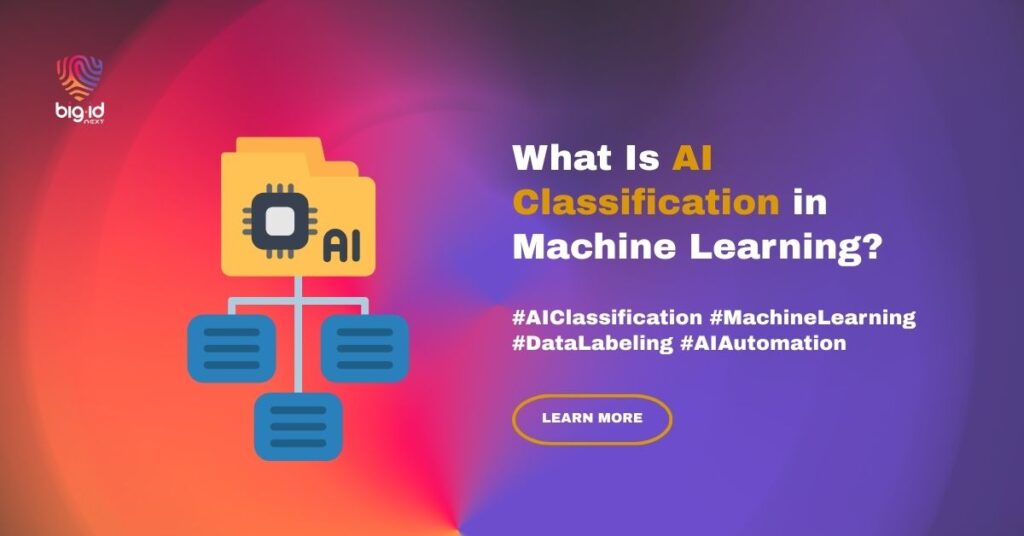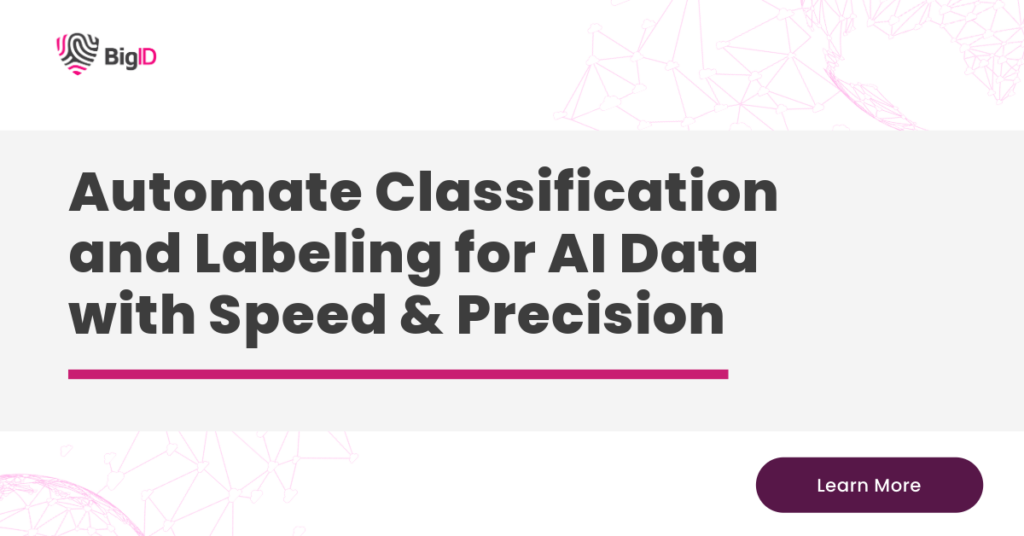What Is AI Classification in Machine Learning?

AI Classification in Machine Learning
We live in the times of big data. Every day, businesses and individuals generate vast quantities of information and delegate its management and analysis to AI. To do so effectively, AI systems need to be able to classify the data.
To understand how they do so, let’s look at what AI classification is.
What Is AI Data Classification?
AI data classification, or AI classification, is the process of organizing data into predefined categories. The AI model is taught to recognize features and patterns in information, so it can identify them in any new data sets.
AI classification is especially useful for understanding unstructured data. That’s logical because structured data doesn’t really need to be classified; as the name suggests, it’s already structured. However, the information hidden within unstructured data can be used for predictive analysis, filtering out spam, generating recommendations, and image recognition.
Types of Artificial Intelligence Classification
Unstructured data isn’t just a single type, so AI models need different algorithms, depending on the desired outcomes. Each algorithm is designed for the type of problem you want to solve and the kind of data available.
Here are some of the most common types of AI classification:
Binary Classification
In certain cases, your AI classification algorithm only needs to classify the data into one of two categories. It’s either “on” or “off,” “yes” or “no,” “right” or “wrong,” and so on. This type of classification is called binary.
Where would such a classification be used? It’s useful for spam detection in your emails in your inbox. They can either be spam or not. Is a financial transaction fraud or not? Should a loan application be approved or not, based on the applicant’s financial history and current details?
These types of decisions only have two outcomes, which is what the AI helps you with.
Multiclass Classification
Where binary classification only dealt with two class labels, multiclass classification deals with more. For example, in addition to detecting “spam” or “not spam,” an email client might also categorize your emails as “promotional,” “social,” “important,” etc.
Another example is if the machine learning model is used to “read” numbers in images, like phone numbers or hand-written zip codes on envelopes. Each symbol must be classified into one of 10 classes—corresponding to digits 0 through 9.
In short, multiclass classification is very similar to binary, except it deals with more than two possible categories. However, it’s important to remember that even though there are multiple classes, a data object can only be assigned to one of them. The email can be either a promotion or a social media notification, not both. A digit can only be 1 or 7—not both at the same time.
Multilabel Classification
The previous categories dealt with options that could only be assigned to one class, whether out of two or out of many. Multilabel classification becomes more complex. Here, an object can belong to more than one category. For example, a dog can be “animal,” “Labrador Retriever,” “black,” “hunting dog,” etc, all at the same time.
It’s very similar to tags you might have seen on news articles or blog posts. A story about data security might be categorized under “security,” “data,” “security incidents,” as well as “data security automation.”
Or, when a streaming platform classifies a movie, which could be a “comedy” as well as a “romance.”
Imbalanced Classification
This type of classification is more complex than the others. Imbalanced classification, as the name suggests, deals with data sets where one class significantly outweighs the other.
For example, hundreds of thousands of people might get tested, but only a few are diagnosed with cancer. Similarly, only a few in millions of credit card transactions might be fraudulent. The rest are perfectly legitimate. Or, every year, a small number of students might drop out, but the vast majority will stay enrolled.
In each of these cases, you want to detect or predict a rare event. However, the data your model is being trained on is skewed towards the opposite class.
AI models often base their results on probabilities. If something is unlikely to happen, they will ignore the 0.001% chance of it happening and focus on the 99.999% chance of it not happening.
However, in the cases we mentioned, you’d rather have a false positive than a false negative. If there’s a chance the result is cancer, the transaction is fraudulent, the student is likely to drop out, you want to know so you can intervene. You’d rather have it flagged so a human expert can assess it instead of it slipping through the cracks in the guise of a statistical improbability.
Yes, the training data leans towards a negative, but your machine learning algorithm needs to factor this in. Otherwise, you are going to get a model that is likely to dismiss a significant incident as normal just because it’s statistically unlikely.
How Are AI Data Classification Algorithms Trained?
Now that we know the common classifications, let’s take a look at how AI models are trained to carry them out. It’s not very different from how you would teach a child.
For example, let’s say you’re teaching a young child about animals, birds, and fruits. You might show them pictures and point out specific characteristics that identify them. An apple is red and round, while a banana is yellow and long. If the animal has black and white stripes, it’s a zebra, while yellow and black stripes mean it’s a tiger.
An AI classification model uses a similar approach for supervised learning, and the process has two steps:
Model Learning
In this step, the model is provided with training data. This has been systematically labeled with the correct class. By looking at this organized information, the AI system can start understanding patterns.
For example, an AI tool used for sorting mail might be shown a large number of hand-written addresses. Since they are all properly labeled, the system can learn how people write characters. This allows it to scan through addresses on envelopes and classify them by zip codes.
Model Evaluation
Once the model is trained, the next step is to test how well it has learned. To do so, it is provided with another data set, different from the training information, but equally well-labeled. However, this time, it can’t see the labels, so it’s supposed to make its own guesses based on what it has learned. Its outputs are then compared with the labels to calculate its accuracy.
So, if we go back to our mail sorting example, the model might be given a new batch of hand-written addresses, and asked to read and classify the zip codes on its own. Its outputs are then compared with the actual zip codes, and the performance is measured against metrics such as:
- Accuracy: The percentage of correct answers.
- Precision: If the model says a symbol is the number 7, how often is it correct?
- Recall: Of all the times the number 7 appears, how many times does the model catch it?
- F1 score: A balanced metric that combines precision and recall, useful for uneven data or challenging categories.
If the model doesn’t perform well enough, it might be “sent back” for retraining. Based on the results, it may need more training data, different features, or adjustments to its internal parameters.

Common Types of Classification Algorithms Used by AI Models
We talked about model learning, but how does a model use training data to learn? This is where training algorithms come into play. These algorithms can be divided into two categories: Eager learners and lazy learners.
The former are models that are trained before they are deployed, while the latter aren’t trained. They are simply given the training data, which they memorize. Then, when they receive an input, they find its closest counterpart in the training set to make a decision.
Let’s take a look at some of them, starting with the eager learners first:
Logistic Regression
This is an algorithm that helps a model make a binary decision, or a choice between two outcomes. It looks at the input data and calculates the probability of it falling into one category or another. For example, it might look at a person’s credit history, the number of times they’ve defaulted on a loan in the past, and their current financial situation. It might then use this information to calculate the likelihood of this person defaulting on a loan again, and use that probability to decide on a “yes” or “no” for their loan application.
Decision Trees
A decision tree is like a flowchart, where each branch represents a condition or choice. You might have used this type of logic to decide what to have for dinner. It might start at a very top-level decision, where you decide whether you want to cook or eat out.
If you choose to eat out, “What kind of food sounds good tonight?”
Then, “Do you want to go out or get a takeaway?”
AI models use decision trees in a very similar way.
For example, in our loan application example, the AI solution might look at various factors before deciding the outcome. It might start with their income, where if it’s under a certain amount, the application is rejected immediately. If it’s above the threshold, then it might ask, “Have they ever defaulted on a loan before?”
The process continues until it has enough information to make a decision: approve the loan application or reject it.
Random Forests
The reason why this algorithm is called a forest is that it has a lot of trees. Instead of a single decision tree, a random forest uses multiple trees, each prioritizing a different factor.
Our loan application model might focus on the applicant’s salary in one tree, their payment history in another, with a new one for job stability, and so on. Each tree looks at a different part of the data affecting the outcome. The model then combines each of their results to make a more balanced, reliable decision.
Support Vector Machines
Commonly shortened to SVM, the support vector machine model is an algorithm that separates data into two or more categories by finding the best boundary between them. It uses input features to create a map of data points, and uses this map to see where the new data should be placed.
Returning to our loan application example, the model might take features like salary, rate of default, and other relevant factors to learn the pattern that separates approved applications from rejected ones. This virtual dividing line is called the SVM decision boundary. Then, when it gets new input, it assesses where it falls on this graph, relative to the boundary, to make a decision.
Neural Networks
Decision trees are rule-based, where each decision is made based on clearly defined steps. Random forests are also rule-based, but they also have a “voting” system, where multiple trees reach a consensus. Neural networks are the closest to the way human beings learn and process information.
A neural network is made up of several layers of decision-making units, often called neurons. Each unit processes one part of the input and passes its results on to the next layer.
Like our brain, each decision is used as a learning opportunity. This helps the model get better and better at predicting outcomes, even when the data it receives is unclear, complex, or messy. This makes it extremely suitable for deep learning models.
K-Nearest Neighbors
The first of the lazy learners, KNN is an algorithm that classifies data inputs based on their similarity to what it’s already seen. As a typical lazy learner, it doesn’t build a model in advance. Instead, it stores all of its training data and waits until it needs to make a decision.
If our loan approval model were based on this algorithm, it would look at all the past applications that are similar to the current one. If most of them were approved, it would approve this one as well, or vice versa.
KNN is ideal for use cases where the relationship between inputs and outputs is complex, but local patterns matter. It’s extremely simple and intuitive, and doesn’t require a long training period.
Naive Bayes
Another lazy learner, Naive Bayes uses probability to make predictions. It looks at the input data and classifies it under the most likely category. It calculates the likelihood of each possible outcome and picks the most probable one.
The reason why it’s called naive is that it treats each input feature as if it’s independent of the others. Despite that, it works really well, especially for text classification tasks, like spam filtering or sentiment analysis.
Use Cases of AI Data Classification in Machine Learning
Fraud Detection
AI models can monitor activity in real time to categorize it into “regular” or “suspicious.” If there are any signs of irregular behavior, the system can flag it so a human can assess it.
Customer Segmentation
AI can classify customers into different classes based on their browsing history, preferences, previous purchases, and more. This allows you to plan marketing and upselling campaigns that are more strategic and likely to yield better results.
Medical Diagnosis
You can run the results of medical tests (like X-Rays, scans, bloodwork, etc.) or patient data (such as their genetic profile and family medical history) through your AI model to get a faster — and potentially more accurate — diagnosis.
Natural Language Processing (NLP)
Ever wondered what people are saying about your business and if it’s positive or negative? AI models can analyze words to classify reviews or social media posts into “positive,” “negative,” or “neutral” categories. You can then focus your efforts on improving your customer experience by looking at what people don’t like about the way you do things.
Managing Your AI Classification Data with BigID
AI classification is only as good as the data it learns from. Whether you’re detecting fraud or automating business decisions, the model depends entirely on the quality, structure, and security of the data it’s trained on.
Poorly labeled, unstructured, or unsecured data can lead to inaccurate predictions, biased results, and compliance risks. All of these can derail your AI strategy before it even begins.
That’s why it’s important to not only build smart models, but also to manage your data intelligently.
Data classification is a core part of the BigID platform. It’s designed to help your business govern, organize, and protect data at scale. From identifying sensitive information to automatically labeling and securing it across your environments, BigID makes your data AI-ready and responsibly managed.
Want to see how AI-driven classification works in practice? Explore BigID’s AI data classification solution.













